radio Ram 2500 2017 Repair Manual
[x] Cancel search | Manufacturer: RAM, Model Year: 2017, Model line: 2500, Model: Ram 2500 2017Pages: 734, PDF Size: 7.3 MB
Page 557 of 734

Recommended Distribution Hitch Adjustment
Towing With 1500 Air Suspension
1. Set air suspension to normal ride height. No action isrequired if already in normal ride height.
NOTE: The vehicle must remain in the engine run position
with all doors closed while attaching a trailer for proper
leveling of the air suspension system.
2. Position the truck to be ready to connect to the trailer (do not connect the trailer). 3. Under the instrument cluster or touch screen radio
settings, enable jack mode. Jack mode will be canceled
and procedure must be restarted if the vehicle is driven
at speeds above 5mph (8 kmh).
4. Measure the height of the top of the front wheel opening on the fender to ground, this is height H1.
5. Attach the trailer to the vehicle without the weight distribution bars connected.
6. Measure the height of the top of the front wheel opening on the fender to ground, this is height H2.
Improper Adjustment Of Weight-Distributing Hitch
(Incorrect)
Measuring Height (H)
5
STARTING AND OPERATING 555
Page 558 of 734
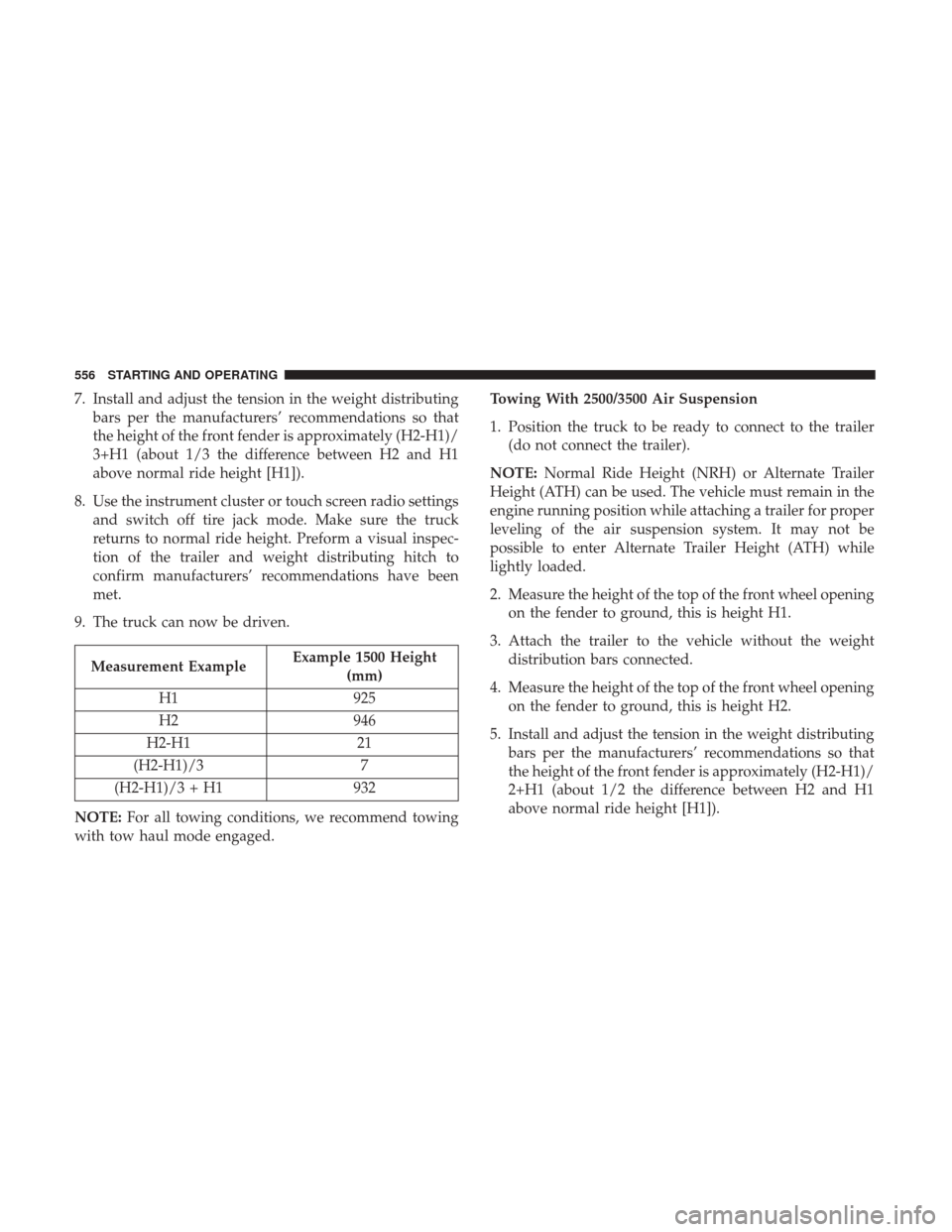
7. Install and adjust the tension in the weight distributingbars per the manufacturers’ recommendations so that
the height of the front fender is approximately (H2-H1)/
3+H1 (about 1/3 the difference between H2 and H1
above normal ride height [H1]).
8. Use the instrument cluster or touch screen radio settings and switch off tire jack mode. Make sure the truck
returns to normal ride height. Preform a visual inspec-
tion of the trailer and weight distributing hitch to
confirm manufacturers’ recommendations have been
met.
9. The truck can now be driven.
Measurement Example Example 1500 Height
(mm)
H1 925
H2 946
H2-H1 21
(H2-H1)/3 7
(H2-H1)/3 + H1 932
NOTE: For all towing conditions, we recommend towing
with tow haul mode engaged. Towing With 2500/3500 Air Suspension
1. Position the truck to be ready to connect to the trailer
(do not connect the trailer).
NOTE: Normal Ride Height (NRH) or Alternate Trailer
Height (ATH) can be used. The vehicle must remain in the
engine running position while attaching a trailer for proper
leveling of the air suspension system. It may not be
possible to enter Alternate Trailer Height (ATH) while
lightly loaded.
2. Measure the height of the top of the front wheel opening on the fender to ground, this is height H1.
3. Attach the trailer to the vehicle without the weight distribution bars connected.
4. Measure the height of the top of the front wheel opening on the fender to ground, this is height H2.
5. Install and adjust the tension in the weight distributing bars per the manufacturers’ recommendations so that
the height of the front fender is approximately (H2-H1)/
2+H1 (about 1/2 the difference between H2 and H1
above normal ride height [H1]).
556 STARTING AND OPERATING
Page 582 of 734
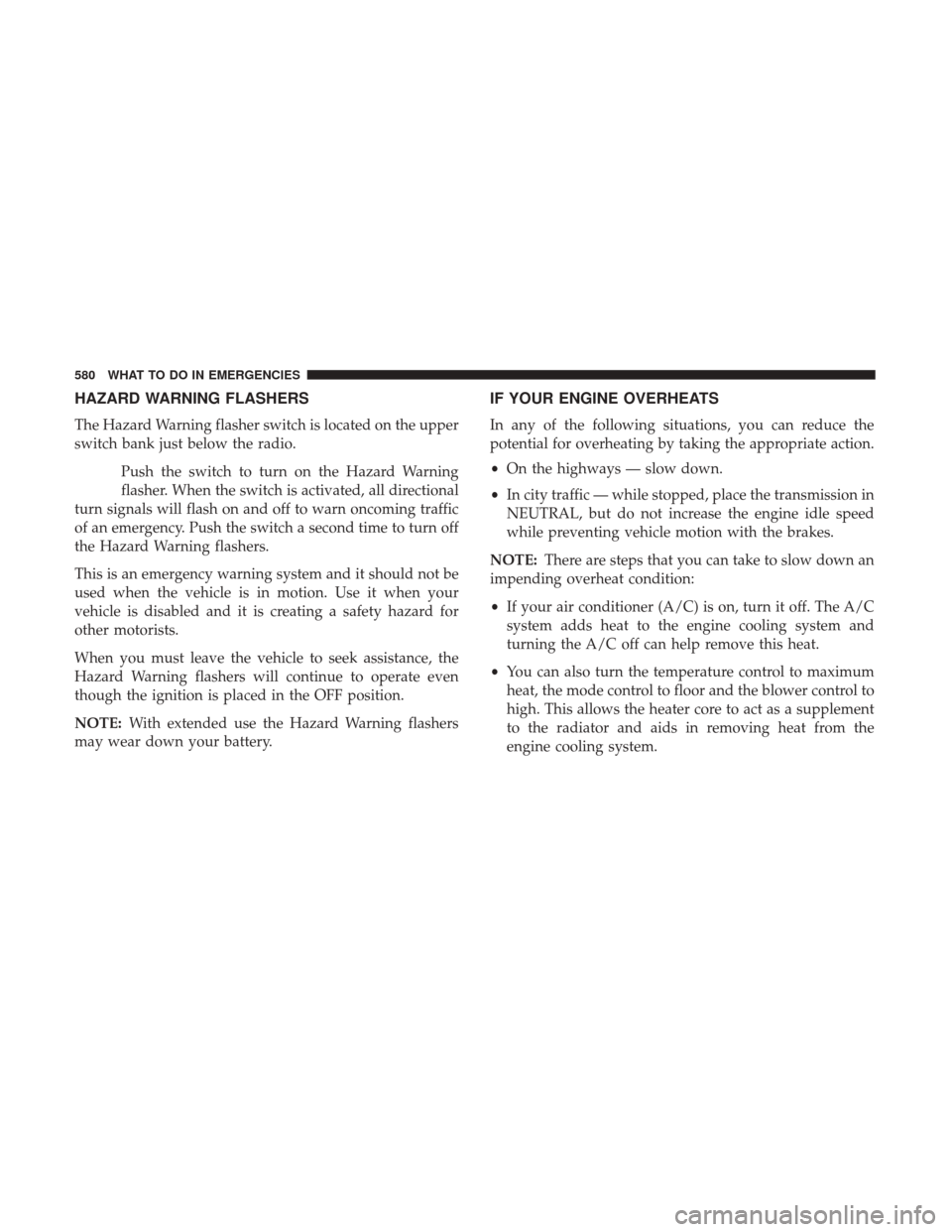
HAZARD WARNING FLASHERS
The Hazard Warning flasher switch is located on the upper
switch bank just below the radio.Push the switch to turn on the Hazard Warning
flasher. When the switch is activated, all directional
turn signals will flash on and off to warn oncoming traffic
of an emergency. Push the switch a second time to turn off
the Hazard Warning flashers.
This is an emergency warning system and it should not be
used when the vehicle is in motion. Use it when your
vehicle is disabled and it is creating a safety hazard for
other motorists.
When you must leave the vehicle to seek assistance, the
Hazard Warning flashers will continue to operate even
though the ignition is placed in the OFF position.
NOTE: With extended use the Hazard Warning flashers
may wear down your battery.
IF YOUR ENGINE OVERHEATS
In any of the following situations, you can reduce the
potential for overheating by taking the appropriate action.
• On the highways — slow down.
• In city traffic — while stopped, place the transmission in
NEUTRAL, but do not increase the engine idle speed
while preventing vehicle motion with the brakes.
NOTE: There are steps that you can take to slow down an
impending overheat condition:
• If your air conditioner (A/C) is on, turn it off. The A/C
system adds heat to the engine cooling system and
turning the A/C off can help remove this heat.
• You can also turn the temperature control to maximum
heat, the mode control to floor and the blower control to
high. This allows the heater core to act as a supplement
to the radiator and aids in removing heat from the
engine cooling system.
580 WHAT TO DO IN EMERGENCIES
Page 621 of 734
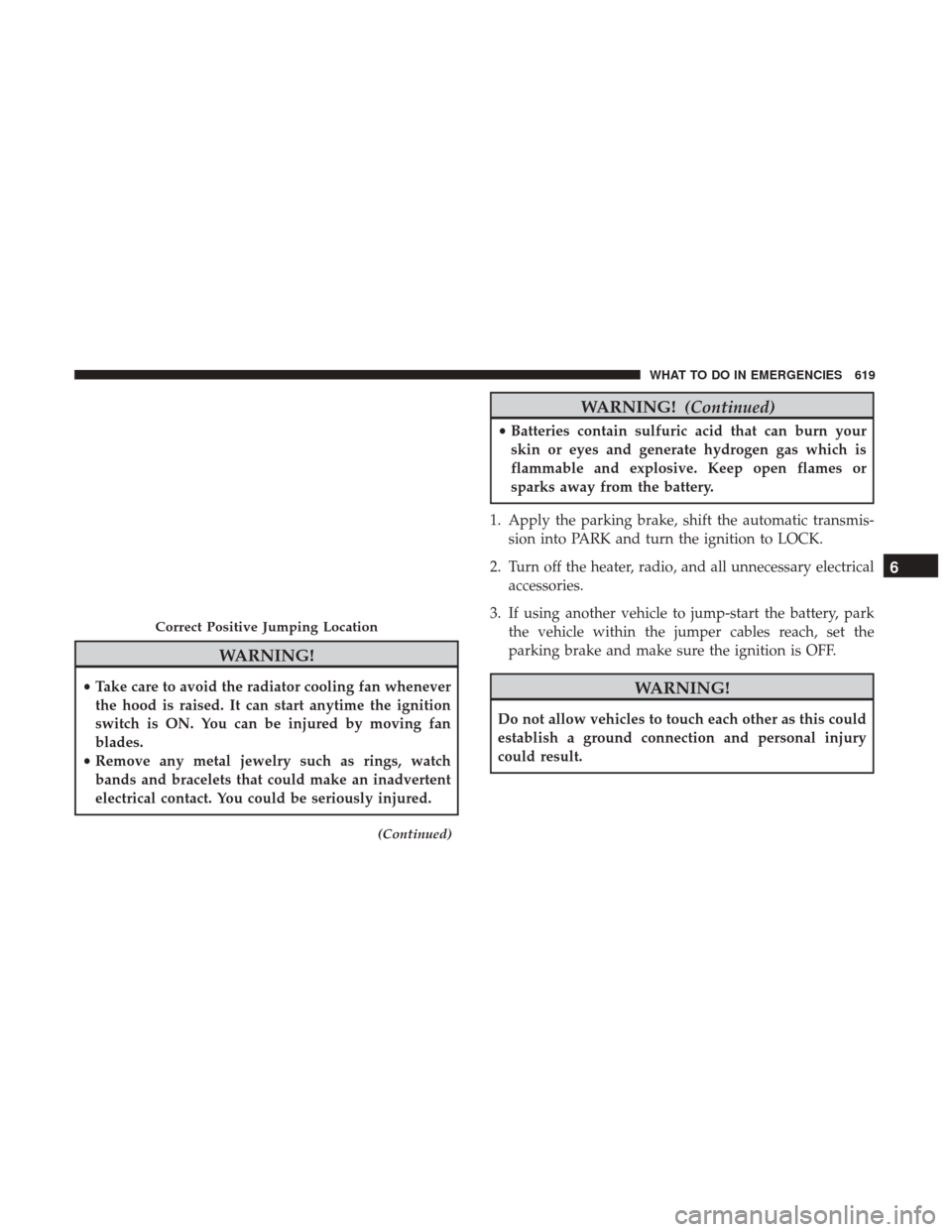
WARNING!
•Take care to avoid the radiator cooling fan whenever
the hood is raised. It can start anytime the ignition
switch is ON. You can be injured by moving fan
blades.
• Remove any metal jewelry such as rings, watch
bands and bracelets that could make an inadvertent
electrical contact. You could be seriously injured.
(Continued)
WARNING! (Continued)
•Batteries contain sulfuric acid that can burn your
skin or eyes and generate hydrogen gas which is
flammable and explosive. Keep open flames or
sparks away from the battery.
1. Apply the parking brake, shift the automatic transmis- sion into PARK and turn the ignition to LOCK.
2. Turn off the heater, radio, and all unnecessary electrical accessories.
3. If using another vehicle to jump-start the battery, park the vehicle within the jumper cables reach, set the
parking brake and make sure the ignition is OFF.
WARNING!
Do not allow vehicles to touch each other as this could
establish a ground connection and personal injury
could result.
Correct Positive Jumping Location
6
WHAT TO DO IN EMERGENCIES 619
Page 639 of 734
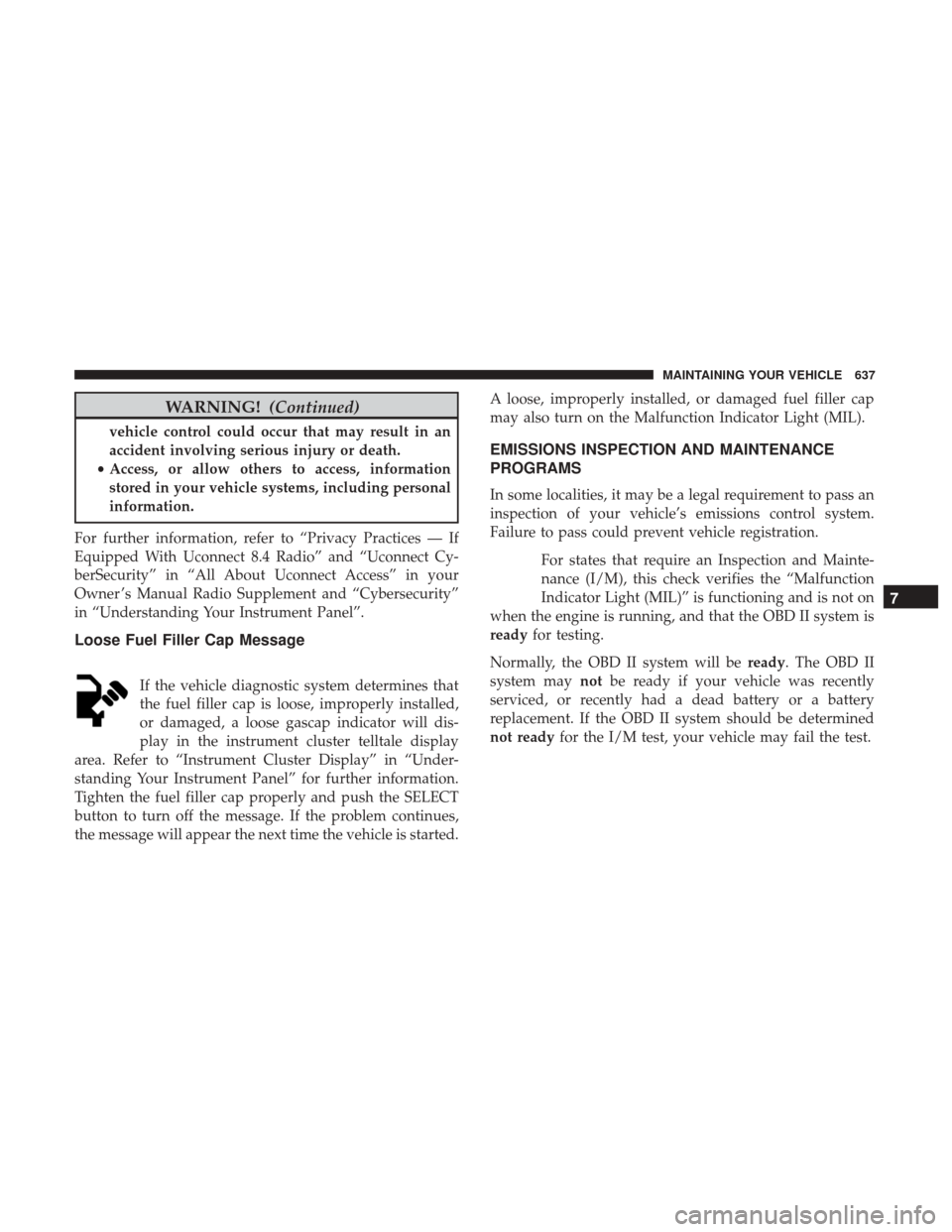
WARNING!(Continued)
vehicle control could occur that may result in an
accident involving serious injury or death.
• Access, or allow others to access, information
stored in your vehicle systems, including personal
information.
For further information, refer to “Privacy Practices — If
Equipped With Uconnect 8.4 Radio” and “Uconnect Cy-
berSecurity” in “All About Uconnect Access” in your
Owner ’s Manual Radio Supplement and “Cybersecurity”
in “Understanding Your Instrument Panel”.
Loose Fuel Filler Cap Message
If the vehicle diagnostic system determines that
the fuel filler cap is loose, improperly installed,
or damaged, a loose gascap indicator will dis-
play in the instrument cluster telltale display
area. Refer to “Instrument Cluster Display” in “Under-
standing Your Instrument Panel” for further information.
Tighten the fuel filler cap properly and push the SELECT
button to turn off the message. If the problem continues,
the message will appear the next time the vehicle is started. A loose, improperly installed, or damaged fuel filler cap
may also turn on the Malfunction Indicator Light (MIL).
EMISSIONS INSPECTION AND MAINTENANCE
PROGRAMS
In some localities, it may be a legal requirement to pass an
inspection of your vehicle’s emissions control system.
Failure to pass could prevent vehicle registration.
For states that require an Inspection and Mainte-
nance (I/M), this check verifies the “Malfunction
Indicator Light (MIL)” is functioning and is not on
when the engine is running, and that the OBD II system is
ready for testing.
Normally, the OBD II system will be ready. The OBD II
system may notbe ready if your vehicle was recently
serviced, or recently had a dead battery or a battery
replacement. If the OBD II system should be determined
not ready for the I/M test, your vehicle may fail the test.
7
MAINTAINING YOUR VEHICLE 637
Page 679 of 734

CAUTION!
Do not use Alcohol and Alcohol-based and/or Keton
based cleaning products to clean leather seats, as
damage to the seat may result.
Cleaning Headlights
Your vehicle is equipped with plastic headlights and fog
lights that are lighter and less susceptible to stone breakage
than glass headlights.
Plastic is not as scratch resistant as glass and therefore
different lens cleaning procedures must be followed.
To minimize the possibility of scratching the lenses and
reducing light output, avoid wiping with a dry cloth. To
remove road dirt, wash with a mild soap solution followed
by rinsing.
Do not use abrasive cleaning components, solvents, steel
wool or other aggressive material to clean the lenses.
Glass Surfaces
All glass surfaces should be cleaned on a regular basis with
MOPAR Glass Cleaner, or any commercial household-type
glass cleaner. Never use an abrasive type cleaner. Use
caution when cleaning the inside rear window equippedwith electric defrosters or windows equipped with radio
antennas. Do not use scrapers or other sharp instrument
that may scratch the elements.
When cleaning the rear view mirror, spray cleaner on the
towel or cloth that you are using. Do not spray cleaner
directly on the mirror.
Cleaning Plastic Instrument Cluster Lenses
The lenses in front of the instruments in this vehicle are
molded in clear plastic. When cleaning the lenses, care
must be taken to avoid scratching the plastic.
1. Clean with a wet soft cloth. A mild soap solution may be
used, but do not use high alcohol content or abrasive
cleaners. If soap is used, wipe clean with a clean damp
cloth.
2. Dry with a soft cloth.
Seat Belt Maintenance
Do not bleach, dye or clean the belts with chemical solvents
or abrasive cleaners. This will weaken the fabric. Sun
damage can also weaken the fabric.
If the belts need cleaning, use a mild soap solution or
lukewarm water. Do not remove the belts from the vehicle
to wash them. Dry with a soft cloth.
7
MAINTAINING YOUR VEHICLE 677
Page 727 of 734
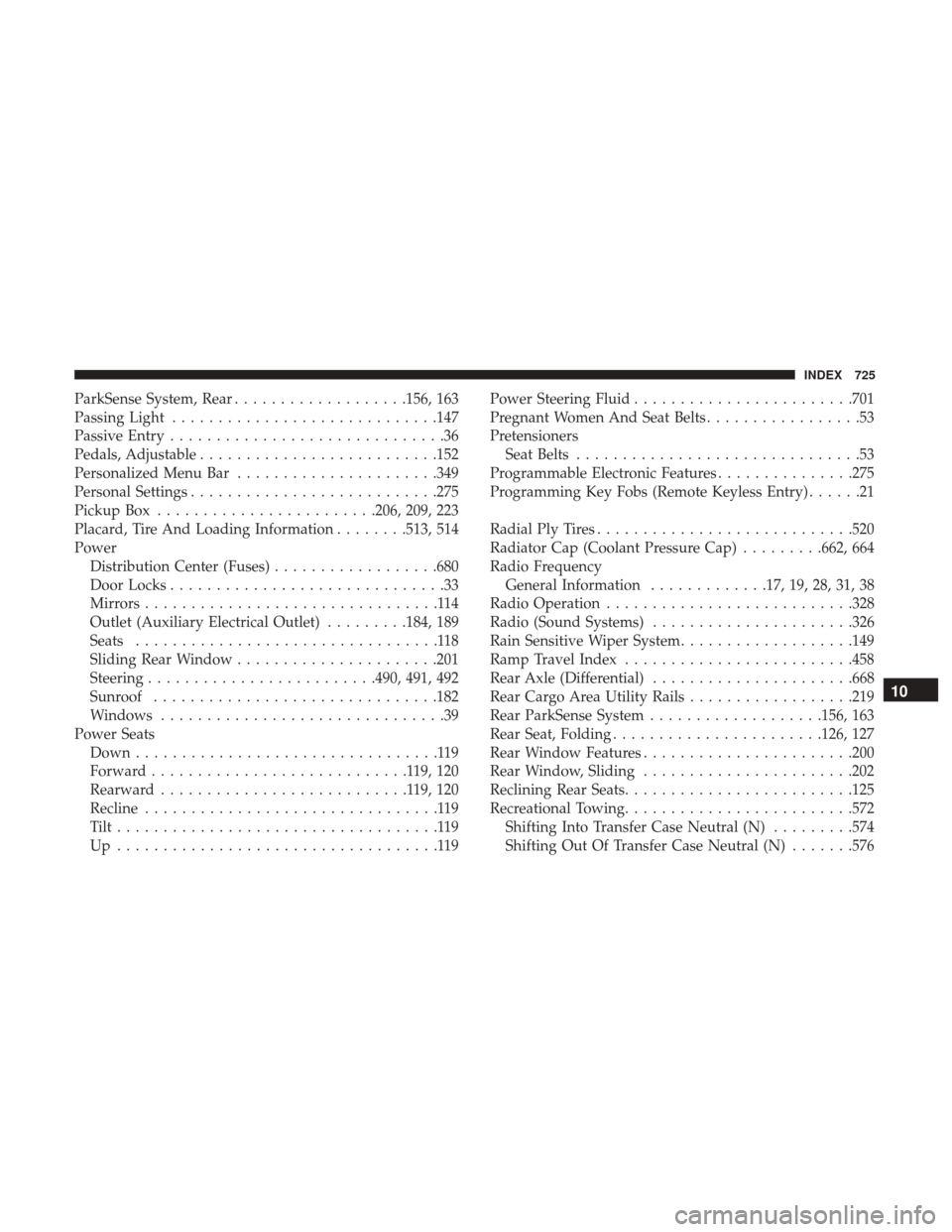
ParkSense System, Rear...................156, 163
Passing Light ............................ .147
Passive Entry ..............................36
Pedals, Adjustable ......................... .152
Personalized Menu Bar ..................... .349
Personal Settings .......................... .275
Pickup Box ....................... .206, 209, 223
Placard, Tire And Loading Information ........513, 514
Power Distribution Center (Fuses) ..................680
Door Locks ..............................33
Mirrors ................................114
Outlet (Auxiliary Electrical Outlet) .........184, 189
Seats .................................118
Sliding Rear Window ..................... .201
Steering ........................ .490, 491, 492
Sunroof .............................. .182
Windows ...............................39
Power Seats Down .................................119
Forward ............................119,120
Rearward ...........................119,120
Recline ................................119
Tilt...................................119
Up ...................................119 Power Steering Fluid
....................... .701
Pregnant Women And Seat Belts .................53
Pretensioners Seat Belts ...............................53
Programmable Electronic Features ...............275
Programming Key Fobs (Remote Keyless Entry) ......21
Radial Ply Tires ........................... .520
Radiator Cap (Coolant Pressure Cap) .........662, 664
Radio Frequency General Information .............17, 19, 28, 31, 38
Radio Operation .......................... .328
Radio (Sound Systems) ..................... .326
Rain Sensitive Wiper System ...................149
Ramp Travel Index ........................ .458
Rear Axle (Differential) ..................... .668
Rear Cargo Area Utility Rails ..................219
Rear ParkSense System ...................156, 163
Rear Seat, Folding ...................... .126,
127
Rear Window Features ...................... .200
Rear Window, Sliding ...................... .202
Reclining Rear Seats ........................ .125
Recreational Towing ........................ .572
Shifting Into Transfer Case Neutral (N) .........574
Shifting Out Of Transfer Case Neutral (N) .......576
10
INDEX 725
Page 728 of 734

Reformulated Gasoline...................... .542
Refrigerant ........................... .649, 650
Reminder, Seat Belt ..........................43
Remote Control Starting System ...........................29
Remote Keyless Entry ..................... .21, 22
Programming Additional Key Fobs .............18
Remote Sound System (Radio) Controls ...........327
Remote Starting Uconnect Customer Programmable
Features ........................... .297, 317
Uconnect Settings .....................297, 317
Remote Starting System .......................29
Replacement Bulbs ........................ .688
Replacement Keys ...........................18
Replacement Parts ......................... .639
Replacement Tires ......................... .527
Reporting Safety Defects .....................713
Restraint, Head ........................... .129
Restraints, Child ............................69
Rotation, Tires ............................ .530
Safety Checks Inside Vehicle ...................95
Safety Checks Outside Vehicle ..................98
Safety Defects, Reporting .....................713 Safety, Exhaust Gas
..........................95
Safety Information, Tire ..................... .508
Safety Tips ................................94
Schedule, Maintenance ...................... .704
Seat Belt Adjustable Upper Shoulder Belt Anchorage .......48
Automatic Locking Retractor (ALR) ............54
Lap/Shoulder Belt Operation .................47
Lap/Shoulder Belt Untwisting ................48
Pregnant Women .........................53
Seat Belt Extender .........................52
Seat Belt Pretensioner ......................53
Seat Belt Reminder ........................43
Seat Belt Maintenance ...................... .677
Seat Belt Reminder ..........................43
Seat Belts ............................. .43, 95
Adjustable Shoulder Belt ....................48
Adjustable Upper Shoulder Anchorage ..........48
Child Restraint ...........................69
Extender ...............................52
Front Seat ........................... .43,
47
Inspection ..............................95
Operating Instructions ......................47
Pregnant Women .........................53
Pretensioners ............................53
726 INDEX
Page 733 of 734

INSTALLATION OF RADIO TRANSMITTING
EQUIPMENTSpecial design considerations are incorporated into this
vehicle’s electronic system to provide immunity to radio
frequency signals. Mobile two-way radios and telephone
equipment must be installed properly by trained person-
nel. The following must be observed during installation.
The positive power connection should be made directly
to the battery and fused as close to the battery as possible.
The negative power connection should be made to body
sheet metal adjacent to the negative battery connection.
This connection should not be fused.
Antennas for two-way radios should be mounted on the
roof or the rear area of the vehicle. Care should be used
in mounting antennas with magnet bases. Magnets may
affect the accuracy or operation of the compass on
vehicles so equipped.The antenna cable should be as short as practical and
routed away from the vehicle wiring when possible. Use
only fully shielded coaxial cable.
Carefully match the antenna and cable to the radio to
ensure a low Standing Wave Ratio (SWR).
Mobile radio equipment with output power greater than
normal may require special precautions.
All installations should be checked for possible interfer-
ence between the communications equipment and the
vehicle’s electronic systems.